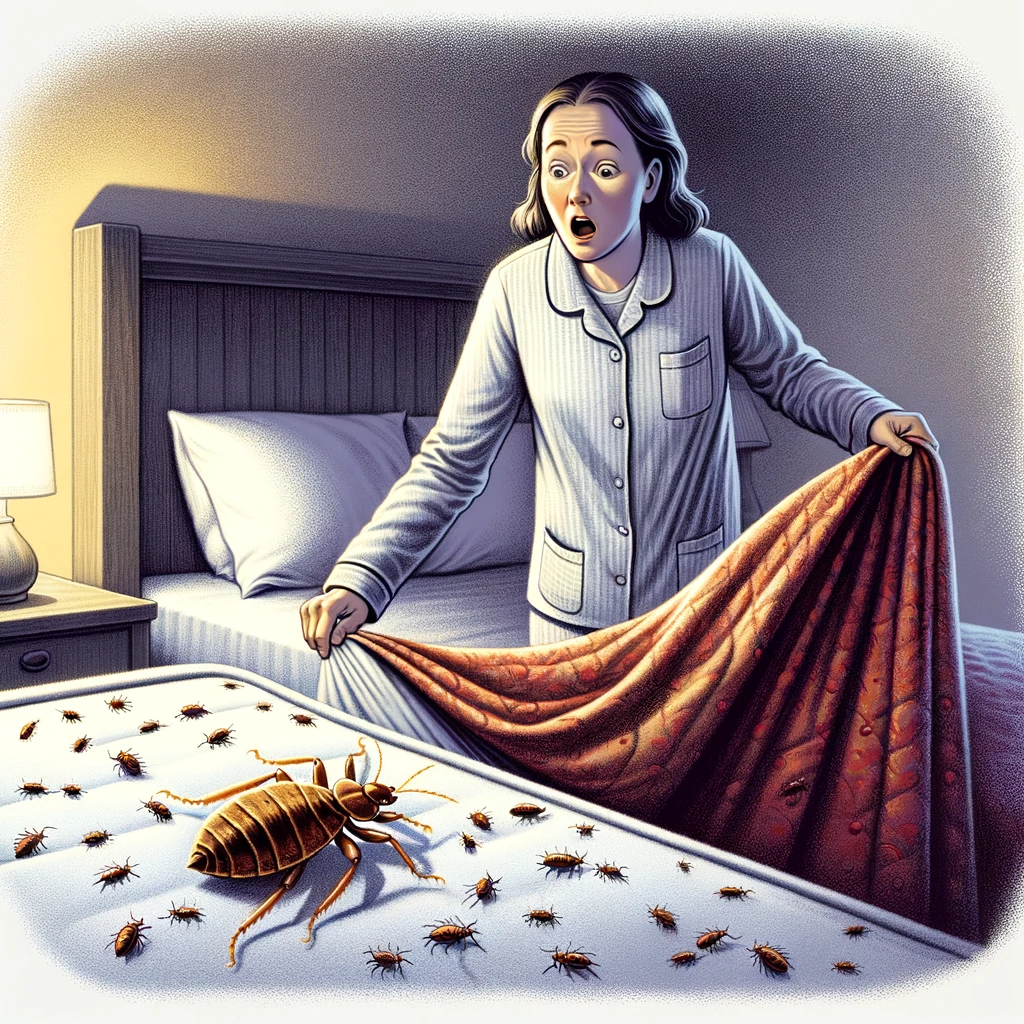Picture this: You’ve just returned from a lovely vacation, sun-kissed and relaxed. But as you’re unpacking, you notice something unsettling—a tiny, reddish-brown bug scurrying across your suitcase. Yup, you’ve unknowingly brought back more than just souvenirs; you’ve got bedbugs. These tiny, unwelcome guests are bedbugs, pesky little critters known for their knack for hitchhiking from one place to another and their love for cozying up in our beds.

Bedbugs are small, flat, and oval insects that feed on the blood of humans and animals while they sleep. They’re sneaky, hiding in the crevices of mattresses, box springs, bed frames, and even behind wallpapers. What makes them particularly troublesome is their ability to go unnoticed for a long time, as they’re nocturnal and exceptionally good at staying hidden during the day.
Finding bedbugs in your home isn’t just a nuisance; it’s a call to action. These bugs are more than just creepy; they can cause allergic reactions, skin rashes, and even affect your mental well-being. The key to tackling this problem is prompt and effective removal. It’s not just about peace of mind; it’s about safeguarding your health and your home. So, let’s dive into the world of bedbug eradication and get your space back to being the cozy, bug-free haven it should be.
Recognizing the Enemy
Identifying bedbugs is the first crucial step in the battle against these unwelcome invaders. Adult bedbugs are small, about the size of an apple seed, and have a distinctive brownish color. They’re flat and oval-shaped when unfed but become redder and balloon-like after a blood meal. Young bedbugs, known as nymphs, are smaller and can be almost colorless before they feed, making them even trickier to spot.
The signs of a bedbug infestation are often more noticeable than the bugs themselves. The most common giveaway? Itchy, red bites on your skin. These bites often appear in a line or a cluster, predominantly on areas of the body left exposed during sleep. Unlike mosquito bites, they may take a few days to become noticeable and can cause considerable discomfort.
Another telltale sign is spotting small blood spots on your sheets or pillowcases. These spots are the unfortunate result of bedbugs being crushed while you toss and turn in your sleep. Additionally, look out for tiny, dark specks on your mattress, bedding, or walls. These specks could be bedbug excrement. In more severe cases, you might notice a musty odor around your bed or furniture.
Bedbugs are not picky about where they reside as long as they’re close to a food source – you! They commonly hide in the seams and crevices of mattresses, box springs, bed frames, and headboards. However, these crafty bugs can also settle in cracks in the walls, behind wallpaper, or inside electrical outlets. They prefer dark, hidden spaces, so they’re often found in cluttered areas or in and around furniture. Being vigilant and recognizing these signs early on is essential to stop an infestation in its tracks and reclaim your home from these pesky invaders.
How Did They Get In?
Understanding how bedbugs enter your home is key to preventing future infestations. Contrary to popular belief, these pests don’t just show up because a home is dirty or messy. In fact, bedbugs are not attracted to dirt or filth; they are simply drawn to warmth, blood, and carbon dioxide, which all homes naturally have.
One of the most common ways bedbugs find their way into your home is through hitchhiking on luggage, clothing, or other personal belongings. This often happens after staying in infested hotels, hostels, or Airbnbs. These critters are master stowaways, so even the briefest stay in an infested area can lead to unwanted guests in your home.

Second-hand furniture is another common culprit. That charming vintage sofa or antique bed frame might come with hidden bedbugs, especially if it was previously in an infested environment. Always inspect second-hand items thoroughly before bringing them into your home.
It’s important to bust the myth that bedbug infestations are a sign of poor hygiene or a dirty household. These pests can thrive in the cleanest of environments, as long as they have access to their food source – human blood. High-end hotels and well-maintained homes are just as susceptible to bedbugs as less clean places. The key is vigilance, not cleanliness alone. By understanding how bedbugs infiltrate homes, you can take proactive measures to keep them out and ensure your living space remains a bedbug-free zone.
DIY Bedbug Battle Plan
When facing a bedbug invasion, your first line of defense can often be a well-executed DIY strategy. Here’s a step-by-step battle plan to help you start the fight against these pesky intruders.
Strip and Wash Bedding: Remove all bedding, linens, curtains, and clothing from the affected area. Wash them in hot water and dry them on the highest dryer setting. Bedbugs can’t survive extreme temperatures, so this can kill both bugs and their eggs.
Vacuum Thoroughly: Use a vacuum cleaner to thoroughly clean your mattress, bed frame, carpets, furniture, and any cracks or crevices where bedbugs might hide. Pay special attention to seams and folds where they love to lurk. Immediately after vacuuming, seal and dispose of the vacuum bag outside your home to prevent the bugs from escaping.
Seal Cracks and Crevices: Seal any cracks in the walls and gaps around baseboards or electrical outlets to cut off bedbug hiding spots and prevent them from spreading to other areas.
Use Over-the-Counter Sprays with Caution: There are numerous over-the-counter bedbug sprays available, but their effectiveness varies. These products can be helpful, but they often only kill bugs on contact and don’t address hidden infestations. Always follow the product instructions to ensure safe and effective use.
Try Natural Remedies: Some natural remedies, like diatomaceous earth, can be effective against bedbugs. Sprinkle it around bed frames, mattresses, and along the baseboards. It works by dehydrating the bugs. Again, be sure to use food-grade diatomaceous earth and follow safety instructions.
Encase Mattress and Box Springs: Consider using a bedbug-proof mattress encasement. These covers seal the bugs inside, preventing them from feeding and reproducing.
Monitor and Repeat: After your initial cleanup and treatment, monitor the affected areas regularly for signs of bedbugs. Repeat cleaning and treatment as necessary.
Safety Tips for DIY Methods:
Always use pesticides and natural remedies according to the label instructions.
Wear protective gloves and masks when using chemical sprays or diatomaceous earth.
Avoid overusing pesticides to prevent harmful exposure and potential health risks.
If you have pets or children, ensure that any treatment you use is safe around them.
Remember, while DIY methods can be effective for mild infestations, they may not always eradicate the problem completely. If the infestation persists or worsens, it’s wise to consult a professional exterminator for a more thorough and potentially more effective treatment plan.
When to Call in the Pros
While DIY methods can be a good starting point, there are times when they just don’t cut it. Bedbugs are notoriously resilient, and their ability to hide in the smallest of spaces means DIY efforts might miss crucial hiding spots. If you’ve tried DIY methods and still see signs of bedbugs, or if the infestation seems extensive from the start, it’s time to call in the professionals.
Professional exterminators have access to a range of more potent and comprehensive treatment options. One popular method is heat treatment, which involves raising the temperature in your home to a level that is lethal to bedbugs but safe for your belongings. This method is particularly effective as it can penetrate into hard-to-reach areas, ensuring that even the most well-hidden bugs are exterminated.
Another common professional approach is chemical treatments. These involve the use of pesticides that are more powerful than over-the-counter options. Exterminators are trained to apply these chemicals safely and effectively, targeting all stages of the bedbug life cycle. Some professionals also use a combination of heat and chemical treatments for maximum effectiveness.
When choosing a pest control service, it’s essential to do your research. Look for a company with a solid reputation and positive reviews. Check if they specialize in bedbug extermination, as this indicates a deeper understanding of how to tackle these specific pests effectively. Don’t hesitate to ask about their methods, safety protocols, and the expected timeline for results. Ensure they offer a follow-up service to check the effectiveness of the treatment.
Remember, the cheapest option isn’t always the best. Investing in a reliable and experienced pest control service can save you time, money, and stress in the long run by ensuring that the bedbug problem is thoroughly resolved.
I have been in the pest control industry for over 25 years and I have to add a personal warning. I have had so many people over the years call me in tears because they have spent thousands of dollars, with multiple companies and have not eliminated the problem. Most of them only had a 30 day guarantee. My suggestion is to never even consider a company that will not give you a six month warrantee. Bedbugs can sit dormant for up to 3 months so a 30 day guarantee is basically useless! Do yourself a favor and get a good warrantee with a reputable company!
Preventing Future Infestations
Having waged war against bedbugs, the last thing you want is a repeat invasion. Prevention is key, and there are several steps you can take to keep these pests at bay.
Regular Inspections: Make it a habit to inspect your sleeping areas regularly. Check the seams of your mattress, bed frames, and box springs for any signs of bedbugs. Don’t forget to inspect other furniture items, especially those with upholstery.
Use Protective Encasements: Consider investing in bedbug-proof encasements for your mattress and box springs. These covers are designed to trap bedbugs inside, preventing them from feeding and breeding, and also keep new bugs from getting in.
Reduce Clutter: A cluttered home provides more hiding places for bedbugs. Keeping your space tidy and organized can make it easier to spot bedbugs early and reduce the risk of a severe infestation.
Be Vigilant While Traveling: Bedbugs are notorious hitchhikers, often entering homes through luggage after trips. When staying in hotels or other accommodations, inspect the bed and furniture. Keep your luggage off the floor—using a luggage rack is a good option. When you return home, wash your travel clothing in hot water and vacuum your suitcase.
Be Cautious with Second-Hand Items: Inspect second-hand furniture, mattresses, or clothing thoroughly before bringing them into your home. If possible, clean or treat these items before they enter your living space.
Educate Yourself and Others: Knowing what bedbugs look like and understanding their behavior can go a long way in prevention. Share this knowledge with family and friends, especially those who travel frequently or bring in second-hand items.
The key to preventing bedbug infestations is a combination of vigilance, regular maintenance, and a proactive approach to managing your living environment. By staying alert and following these tips, you can significantly reduce the risk of another bedbug battle in the future.
Conclusion
In our journey through the unnerving world of bedbugs, we’ve armed ourselves with the knowledge and strategies to effectively combat these resilient pests. We’ve learned to recognize bedbugs and the signs of their presence, understood how they sneak into our homes, and explored both DIY and professional methods to eradicate them. Importantly, we’ve also discussed strategies to prevent future infestations, emphasizing regular inspections and vigilance, especially while traveling.
Remember, while the thought of bedbugs can be distressing, these pests are a problem that can be solved. With the right approach—prompt action, thoroughness, and persistence—you can reclaim your home from these unwanted guests. It’s all about being proactive and not letting your guard down.
So, take a deep breath and start inspecting your space today. Stay alert to the signs of bedbugs, keep your living area tidy, and don’t hesitate to seek professional help if needed. With these tools and knowledge at your disposal, you’re well-equipped to keep your home bedbug-free. Let’s turn the page on bedbugs and enjoy the peace and comfort of our clean, secure living spaces.
7 Quick Bedbug Facts:
1- Did you know that bedbugs can live several months without a meal? This is why they’re often found in vacant homes or furniture.
2- A common misconception is that bedbugs can’t be seen with the naked eye. In reality, adult bedbugs are about the size of an apple seed and are definitely visible.
3- Bedbugs aren’t just found in beds. They can be found in public transportation, movie theaters, and even in office buildings.
4- Bedbugs are sensitive to temperature changes. Exposing them to temperatures above 120°F (49°C) for several hours can effectively kill them.
5- Bedbugs can lay one to five eggs in a day and more than 500 in a lifetime, making professional intervention crucial in severe cases.
6- Regularly vacuuming your home can help remove bedbugs and their eggs from floors, carpets, and crevices.
7- Despite their name, bedbugs can also live in cracks in the wall, furniture, and even behind picture frames, not just in beds.
